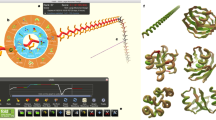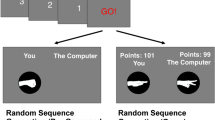Abstract
Humans routinely solve problems of immense computational complexity by intuitively forming simple, low-dimensional heuristic strategies1,2. Citizen science (or crowd sourcing) is a way of exploiting this ability by presenting scientific research problems to non-experts. ‘Gamification’—the application of game elements in a non-game context—is an effective tool with which to enable citizen scientists to provide solutions to research problems. The citizen science games Foldit3, EteRNA4 and EyeWire5 have been used successfully to study protein and RNA folding and neuron mapping, but so far gamification has not been applied to problems in quantum physics. Here we report on Quantum Moves, an online platform gamifying optimization problems in quantum physics. We show that human players are able to find solutions to difficult problems associated with the task of quantum computing6. Players succeed where purely numerical optimization fails, and analyses of their solutions provide insights into the problem of optimization of a more profound and general nature. Using player strategies, we have thus developed a few-parameter heuristic optimization method that efficiently outperforms the most prominent established numerical methods. The numerical complexity associated with time-optimal solutions increases for shorter process durations. To understand this better, we produced a low-dimensional rendering of the optimization landscape. This rendering reveals why traditional optimization methods fail near the quantum speed limit (that is, the shortest process duration with perfect fidelity)7,8,9. Combined analyses of optimization landscapes and heuristic solution strategies may benefit wider classes of optimization problems in quantum physics and beyond.
This is a preview of subscription content, access via your institution
Access options
Subscribe to this journal
Receive 51 print issues and online access
$199.00 per year
only $3.90 per issue
Buy this article
- Purchase on Springer Link
- Instant access to full article PDF
Prices may be subject to local taxes which are calculated during checkout




Similar content being viewed by others
References
McLeod, P. & Dienes, Z. Do fielders know where to go to catch the ball or only how to get there? J. Exp. Psychol. Hum. Percept. Perform. 22, 531–543 (1996)
Gigerenzer, G. & Todd, P. in Simple Heuristics That Make Us Smart (eds Gigerenzer, G., Todd, P. & The ABC Research Group) 3–34 (Oxford Univ. Press, 1999)
Cooper, S. et al. Predicting protein structures with a multiplayer online game. Nature 466, 756–760 (2010)
Lee, J. et al. RNA design rules from a massive open laboratory. Proc. Natl Acad. Sci. USA 111, 2122–2127 (2014)
Kim, J. S. et al. Space-time wiring specificity supports direction selectivity in the retina. Nature 509, 331–336 (2014)
Weitenberg, C., Kuhr, S., Mølmer, K. & Sherson, J. Quantum computation architecture using optical tweezers. Phys. Rev. A 84, 032322 (2011)
Mandelstam, L. & Tamm, I. The uncertainty relation between energy and time in non-relativistic quantum mechanics. J. Phys. 9, 249–254 (1945)
Caneva, T., Calarco, T., Fazio, R., Santoro, G. E. & Montangero, S. Speeding up critical system dynamics through optimized evolution. Phys. Rev. A 84, 012312 (2011)
Gajdacz, M., Das, K. K., Arlt, J., Sherson, J. F. & Opatrný, T. Time limited optimal dynamics beyond the quantum speed limit. Phys. Rev. A 92, 062106 (2015)
Monroe, C. Quantum information processing with atoms and photons. Nature 416, 238–246 (2002)
Lewenstein, M. et al. Ultracold atomic gases in optical lattices: mimicking condensed matter physics and beyond. Adv. Phys. 56, 243–379 (2007)
Devitt, S. J., Munro, W. J. & Nemoto, K. Quantum error correction for beginners. Rep. Prog. Phys. 76, 076001 (2013)
Rabitz, H., Hsieh, M. M. & Rosenthal, C. M. Quantum optimally controlled transition landscapes. Science 303, 1998–2001 (2004)
Sklarz, S. & Tannor, D. Loading a Bose-Einstein condensate onto an optical lattice: an application of optimal control theory to the nonlinear Schrödinger equation. Phys. Rev. A 66, 053619 (2002)
Ugray, Z. et al. Scatter search and local NLP solvers: a multistart framework for global optimization. Inf. J. Comp. 19, 328–340 (2007)
Caneva, T. et al. Optimal control at the quantum speed limit. Phys. Rev. Lett. 103, 240501 (2009)
Bilalić, M., Langner, R., Erb, M. & Grodd, W. Mechanisms and neural basis of object and pattern recognition: a study with chess experts. J. Exp. Psychol. Gen. 139, 728–742 (2010)
Lintott, C. et al. Galaxy Zoo 1: data release of morphological classifications for nearly 900,000 galaxies. Mon. Not. R. Astron. Soc. 410, 166–178 (2011)
Bakr, W. S. et al. Probing the superfluid-to-Mott insulator transition at the single-atom level. Science 329, 547–550 (2010)
Sherson, J. F. et al. Single-atom-resolved fluorescence imaging of an atomic Mott insulator. Nature 467, 68–72 (2010)
Ladd, T. D. et al. Quantum computers. Nature 464, 45–53 (2010)
Weitenberg, C. et al. Single-spin addressing in an atomic Mott insulator. Nature 471, 319–324 (2011)
Kaufman, A. et al. Entangling two transportable neutral atoms via local spin exchange. Nature 527, 208–211 (2015)
De Chiara, G. et al. Optimal control of atom transport for quantum gates in optical lattices. Phys. Rev. A 77, 052333 (2008)
Jäger, G., Reich, D. M., Goerz, M. H., Koch, C. P. & Hohenester, U. Optimal quantum control of Bose–Einstein condensates in magnetic microtraps: comparison of gradient-ascent-pulse-engineering and Krotov optimization schemes. Phys. Rev. A 90, 033628 (2014)
Doria, P., Calarco, T. & Montangero, S. Optimal control technique for many-body quantum dynamics. Phys. Rev. Lett. 106, 190501 (2011)
Caneva, T., Calarco, T. & Montangero, S. Chopped random-basis quantum optimization. Phys. Rev. A 84, 022326 (2011)
Zahedinejad, E., Schirmer, S. & Sanders, B. C. Evolutionary algorithms for hard quantum control. Phys. Rev. A 90, 032310 (2014)
Roslund, J. & Rabitz, H. Experimental quantum control landscapes: inherent monotonicity and artificial structure. Phys. Rev. A 80, 013408 (2009)
Vuculescu, O. & Bergenholtz, C. How to solve problems with crowds: a computer-based simulation model. Creativity Innov. Manage. 23, 121–136 (2014)
Lieberoth, A. et al. Getting humans to do quantum optimization—user acquisition, engagement and early results from the citizen cyberscience game Quantum Moves. Human Comput. 1, 221–246 (2014)
Sauermann, H. & Franzoni, C. Crowd science user contribution patterns and their implications. Proc. Natl Acad. Sci. USA 112, 679–684 (2015)
Calarco, T., Dorner, U., Julienne, P., Williams, C. & Zoller, P. Quantum computations with atoms in optical lattices: marker qubits and molecular interactions. Phys. Rev. A 70, 012306 (2004)
Anderlini, M. et al. Controlled exchange interaction between pairs of neutral atoms in an optical lattice. Nature 448, 452–456 (2007)
Jørgensen, N. B., Bason, M. G. & Sherson, J. F. One- and two-qubit quantum gates using superimposed optical-lattice potentials. Phys. Rev. A 89, 032306 (2014)
Acknowledgements
We thank the Quantum Moves players, without whom this work would have been impossible. We thank J. Rafner for graphical support and J. Jarecki, O. Vuculescu and C. Bergenholtz for discussions. This work was supported by the European Research Council, the Lundbeck Foundation, the Aarhus University Research Foundation, the Templeton Foundation, the Danish Council for Independent Research, the Villum Foundation and the Carlsberg Foundation.
Author information
Authors and Affiliations
Contributions
All authors contributed to the construction of the online game platform and the effort to enlist users. J.J.W.H.S., M.K.P., T.P., M.G.A., M.G., K.M. and J.F.S. participated in the numerical analysis of the player and computer results. All authors contributed to the writing of the manuscript.
Corresponding author
Ethics declarations
Competing interests
The authors declare no competing financial interests.
Extended data figures and tables
Extended Data Figure 1 Deviations from sin2(•) behaviour.
Colouring as in Fig. 2. a, The fidelity as a function of duration for the optimal families rescaled by the apparent QSL. The TQSL is found for each solution by fitting sin2(aT + b) where a and b are fitting parameters. The black line shows sin2(π/2T) for reference. The inset shows the infidelity (1 − F) as a function of duration close to the  . b, The direct Hilbert velocity 〈Q〉T for the best solutions found by the HILO (purple), tunnelling (yellow) and shovelling (blue) clans respectively. Note that 〈Q〉T is only defined for durations with F < 1, so the curves end at different durations. The varying direct Hilbert velocity explains the deviation from
. b, The direct Hilbert velocity 〈Q〉T for the best solutions found by the HILO (purple), tunnelling (yellow) and shovelling (blue) clans respectively. Note that 〈Q〉T is only defined for durations with F < 1, so the curves end at different durations. The varying direct Hilbert velocity explains the deviation from  in a.
in a.
Extended Data Figure 2 The reachability plot for Fig. 3a.
The distance between subsequent solutions as calculated by equation (1) in a list sorted according to the pairwise distance between solutions. The index is the position of the solutions in the list. Valleys identify closely spaced solutions, denoted clans. The valleys corresponding to tunnelling and shovelling clans are marked with yellow and blue respectively. The black line marks the threshold for the distance between consecutive solutions in a clan at 0.05.
Extended Data Figure 3 Solutions from CHOP and HILO.
The amplitude and the position of the tweezer as a function of time for the best player solutions in the tunnelling (yellow) and shovelling (blue) clans and the best HILO (purple). The dashed purple line shows the initial seed used by the best HILO solution (note that the dashed and solid purple lines in the top panel overlap). The total duration is T = 0.15.
Supplementary information
Supplementary Information
The initial version of Quantum Moves: This .jar version includes all the levels used in the original Quantum Moves, on which the results presented here are based. For the new and improved version of Quantum Moves, see http://www.scienceathome.org (ZIP 20131 kb)
Rights and permissions
About this article
Cite this article
Sørensen, J., Pedersen, M., Munch, M. et al. Exploring the quantum speed limit with computer games. Nature 532, 210–213 (2016). https://doi.org/10.1038/nature17620
Received:
Accepted:
Published:
Issue Date:
DOI: https://doi.org/10.1038/nature17620
This article is cited by
-
Conceptual Blending as an Interpretive Lens for Student Engagement with Technology: Exploring Celestial Motion on an Interactive Whiteboard
Research in Science Education (2021)
-
HuGoS: a virtual environment for studying collective human behavior from a swarm intelligence perspective
Swarm Intelligence (2021)
-
Global optimization of quantum dynamics with AlphaZero deep exploration
npj Quantum Information (2020)
-
A Deep Ultraviolet Mode-locked Laser Based on a Neural Network
Scientific Reports (2020)
-
Comparing Groups of Independent Solvers and Transmission Chains as Methods for Collective Problem-Solving
Scientific Reports (2020)
Comments
By submitting a comment you agree to abide by our Terms and Community Guidelines. If you find something abusive or that does not comply with our terms or guidelines please flag it as inappropriate.



